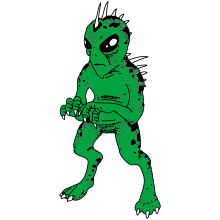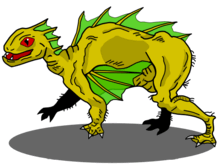- Chupacabras (Legend and Failures)
-
Chupacabras are rumored to stalk livestock in areas all over the world and sightings of the cryptid surfaced in 1995. Many people around the world believe so faithfully in the legends that just through pure belief, they bring the object of the legend to life. Puerto Rico’s Chupacabras appears to have been created as a means to explain the illogical. One failure in this situation is that people willingly accept and play into mass hysteria which has led to devastating consequences.
Chupacabras
The supposed Chupacabras has been identified as a mangy coyoteCreature Grouping Cryptid Data First reported 1995 Country Puerto Rico
Mexico
United StatesRegion Central and North America Contents
History
The Chupacabras has been making a steady comeback in modern sightings since its first major appearance in 1995. The sightings first began in Puerto Rico and since then there has been reported sightings in the United States, Mexico, and Russia. According to legend, the Chupacabras preys on livestock, often slaughtering dozens at a time, draining them of blood through a single puncture mark. Sixteen years later people blame this mysterious creature for weird animal slaughters.
In 2010, two brothers finally admitted to the news that they blamed the Chupacabras for the death of at least 30 chickens. They also claimed that "their rabbits went into hiding, their cat spent the weekend on the roof… their roosters didn't crow, and their dogs didn't bark".[1] The legend continues to transform with each new sighting, despite the numerous ‘Chupacabras’ that have been slain. Years of hearing stories about the Chupacabras has tainted locals into feeling the need to pass on the stories of the creature in order to protect their families and livestock; this story has grown so that nothing can ever truly discredit it fully.
Appearance
The mysterious creature is most commonly depicted as having reptile-like skin with large spikes along its back and head with oval shaped black or red eyes. Other reports mention it looking somewhat bat-like with wings for flying or as having a body shaped like a kangaroos and being capable of jumping great distances. It has also been depicted as having alien-like characteristics which causes people to believe the myth of this animals being extraterrestrial, either because an alien left its pet on earth or through some experimentation. Yet another description has the Chupacabras resembling a hairless wild dog with large fangs.
There are several different descriptions of the creature that exist but in reality several unusual looking animals have been slain in attempts to claim the right to having killed the Chupacabras. However, recently there have been several tests conducted on the slain animals that proved they were mangy coyotes. The consequences in chasing down the Chupacabras have led to the death of dozens of animals.
Failures
"Monsters are everywhere these days, and belief in them is as strong as ever", writes Robert Britt.[2] The need to accept myths and legends without rationality is a failure. These legends can be a quintessential way for people to escape the normal realm in which we live through literature and storytelling. When it comes to the Chupacabras there are mutable stories that circulate the world now and coupled with the media, there is a hysteria that has formed and has attached itself to the legend as well. There are three different ways to view the legend and understand why it exists.
Scientists' View
According to Brian Cronk, a professor of psychology at Missouri Western State University, "the human brain is always trying to determine why things happen, and when the reason is not clear, we tend to make up some pretty bizarre explanations.".[2] In regards to the failure that people willingly accept and add to mass hysteria without just cause, this perspective suggests that legends such as the Chupacabras exist because humans cannot accept the lack of an explanation. This view is more rooted in the idea that dates back to the very beginning of time and how people would buy into the paranormal explanation because they could find no acceptable, logical one. "It's basically the same process as mythology: At one point people didn't understand why the sun rose and set each day, so they suggested that a chariot pulled the sun across the heavens.”.[2] Any bias with this form of thinking could stem from the fact that generally, scientists require tangible proof before something can exist. “Anecdotes are good places to begin an investigation — which by themselves cannot verify a new species…anecdotes do not make a science. Ten anecdotes are no better than one, and a hundred anecdotes are no better than ten,”.[3] Until they have presented to them undeniable facts, scientists will remain skeptical and stick with their facts.
A Scapegoat
One explanation for why so many believe in this creature of legend despite the lack of actual proof and the different descriptions follows the reasoning that human beings need a scapegoat. The race of humans is guilty of “creating certain monsters or creatures which they can put the blame on,”[4] in order to have something else to focus on instead of the actual issues. So geographically, around 1995 when the Chupacabras sightings first began, Puerto Rico was recovering from a two year drought and that brought out the creature. The attacks and sightings of the Chupacabras seem to parallel societal and natural issues, the number of sightings peaking when there are major issues, such as the drought. “Veterinarians and agricultural officials have demonstrated in detailed investigations, there has been an unusual, drought-related hike in the number and ferocity of wild-dog and coyote attacks.”[5] Sightings of the elusive creature basically came to end in 1998 and came back with a vengeance in 2000 when the legend began to spread throughout the world, thus increasing the sightings steadily still today. It could be possible that sightings of the creature only surface when there are other problems raging in society.
Tourism
The Chupacabras became the “avatar of poor people’s deepest fears and an exuberant, tongue-in-cheek emblem of Latin cultural populism.”[5] In Puerto Rico, losing livestock meant losing money and the anxiety made buying into the legend seem more appealing. In 1996, when the first sightings began to appear, the people bought into the legend literally with the sale of ‘chupatacos’ and t-shits;[5] having a monster in town seemed beneficial to the people because of the attention. Money is usually portrayed as a driving factor for people;so when tourism increases because of the mystical creature, why not perpetuate the legend more? Instead of focusing on high crime levels, war, a suffering economy, people, it seems, would rather hunt down mystical creatures and tell tall tales. “Money motivates even the law to look the other way. So while a sheriff might well be concerned if he thinks there's a goat-sucking, menace in town, Zavesky [Sheriff of Cuero, Texas] is in no hurry to catch the beast and debunk the myth. "It has brought a lot of attention to us," he said. "We're not near ready to put this one to bed yet."”.[2]
External links
See also
References
- ^ Koester, Jay (January 13, 2010). "Chicken Deaths near Horizon City Spark Talk of Chupacabras". El Paso Times. http://www.disclose.tv/forum/Chupacabras-suspected-in-el-paso-chicken-deaths-t14601.html. Retrieved February 21, 2011.
- ^ a b c d Britt, Robert. "Monsters, Ghosts and Gods: Why We Believe". Live Science. http://www.livescience.com/5046-monsters-ghosts-gods.html. Retrieved March 15, 2011.
- ^ Shermer, Michael. >. "Show Me the Body". michealshermer.com. http://www.michaelshermer.com/2003/05/show-me-the-body/>.. Retrieved March 17, 2011.
- ^ Vidican, Sergiu (September 6, 2010). "Religion, Monsters, and Paranormal Activities". Metrolic - World News, U.S. News, Multimedia and More. http://www.metrolic.com/religion-monsters-and-paranormal-activities-125798/. Retrieved March 19, 2011.
- ^ a b c Davis, Mike (1997). "Monsters and Messiahs". All American 61: 34–38. JSTOR 25000088.
Categories:- Alleged UFO-related entities
- Carnivorous cryptids
- Hominid cryptids
- Latin American legendary creatures
- Puerto Rican folklore
- Urban legends
- Vampires
Wikimedia Foundation. 2010.



